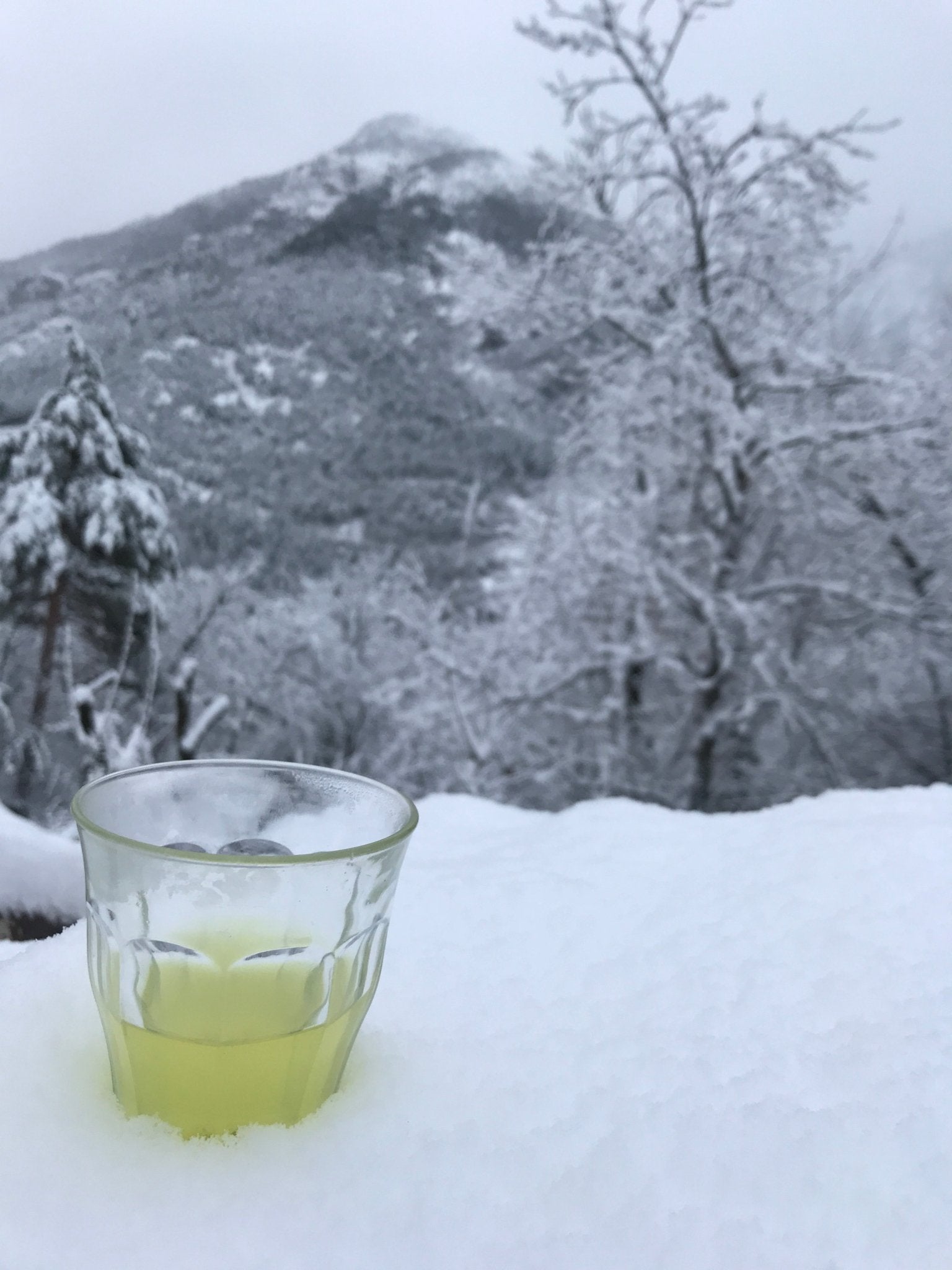A Very Happy New Year to you all!
明けましておめでとうございます!
Despite the challenges associated with traveling and other difficulties during these strange and unique times, we hope that you have been able to see family, friends, or perhaps be in community to the extent that is possible or safe wherever you are. And we also hope that you were able to welcome the New Year with a sense of openness. Without expectations, perhaps like untouched snow...
Did you set any new intentions for the year 2021? I am still contemplating mine, or simply taking it day by day (i.e., without setting concrete intentions). One thing that I would like to make time and space for is more quiet time in the morning, which means waking up earlier! A little bit of movement and quiet with Japanese tea in the morning is a nice way to start the day. With the mindfulness boom, it seems that tea meditation has been touched on a lot now on the Internet. But during my morning cup of tea, what I would really like to make time and space for is to more fully appreciate where the tea is coming from. To think about the tea farmer (sometimes, I am lucky to get to know them a bit from helping write their collection pages for Yunomi), where the tea is coming from, and to envision the context: the place, the people, and perhaps even the feelings that were associated with growing and processing the tea. This was something that Ayumi Kinezuka of Cyittorattu shared with me when I recently interviewed her.
Speaking of the New Year, welcoming the New Year is quite a big deal in Japan. Before the New Year, most households go through a big osōji (Japanese: 大掃除), which is the big cleaning before the turn of the year. Even though I believe the past-present-future are all continuous and interconnected, I very much appreciate the intentions behind this cleaning. It is not just a “physical” clean-up to remove the dust-bunnies and to get rid of unnecessary items, it is often also psychologically and emotionally refreshing. I personally think it’s also important to give some tender loving care to all of your teapot(s), make sure there are no old tea leaves left behind, maybe give it a bit more polishing and love than normal because maybe the teapot spirits also want to celebrate the welcoming of the New Year and would like to dance through the night! I write this retrospectively… but it’s never too late.
While in Spain they eat 12 grapes as the bells reach midnight, in Japan, many households will enjoy a toshikoshi soba (年越し蕎麦). Soba are buckwheat noodles and we appreciate them before welcoming the New Year to wish for longevity and health. The origin of the toshikoshi soba is speculated to have started sometime around the mid-Edo period as soba is auspicious, healthy, but also delicious. Different regions have their own specialty soba so the toppings on the soba may differ but the underlying intention is the same. After welcoming the New Year, some people will even go to hatsumode (初詣) or the first prayer of the year in the wee hours of the morning to pray for good health and to share their intentions at a local or famous shrine. In fact, the shrines can get quite crowded with long lines during this time of year. And then, the firsts continue… in Japan, I guess we appreciate the first dream, the first sunrise, the first view of Mt.Fuji, the first tea in the New Year. What firsts have you been enjoying? Did you treat yourself to a special first tea on New Year's day?

Here are a few firsts from the Yunomi staff: A view of Mt.Fuji, and the first sunrise of the year.
Then on the 1st, families will usually eat osechi-ryori (御節料理), which is traditional food for the New Year. Well, I could continue to share about Japanese culture and traditions during this time, but thinking back on some of the New Years that I spent in Japan, I was reminiscing the days when my Grandparents were still alive. My Grandma on my mother’s side practiced the Japanese Tea ceremony and so on New Year’s day, my family would walk over to her house in the afternoon, usually after our hatsumode in the morning. When I was younger in high school, I remember I did not have much patience for the tea ceremony (which is a shame…) and the perception of time felt rather long as I waited my turn to receive my matcha, specially served by my Grandma. But I recall bits and pieces. Like her explaining parts of the ceremony and after receiving the tea, to also admire the matcha bowl...
Since we are on the topic of tea, you may be wondering if there is any special kind of tea that we drink on New Year’s in Japan. The answer is Yes! And this tea is called an obukucha (or ofukucha). Although, to be honest, I actually have not had obukucha on New Year's day in Japan. Perhaps, this is because I am from Tokyo and obukucha is traditionally enjoyed in the Kansai region (around Kyoto and Osaka). So, what is an obukucha? It is a sencha tea with ume (Japanese plum) and musubi-kombu (knotted kelp). Because of this mix, you’re likely to experience a unique dance of your green tea and the sourness and saltiness coming from your plum and kelp.
Ingredients of obukucha
Musubi konbu (tied kelp): Konbu is a word that has the meaning of ``happy'' and is also written as ``konbu,'' a word that means ``fertility.'' By tying the knot, it has the meaning of uniting joy and strengthening family ties.
Ume (plum): Due to its wrinkly appearance, umeboshi is said to be a lucky charm that prays for longevity and good health. In Japan, plum trees are the first to bloom in the spring time and bear fruit so it is a well respected tree. Additionally, because plum trees have a long lifespan, they are considered to be a fortunate ingredient for longevity.

Ingredients of obukucha. Ume on the left and musubi-kombu on the right. Images from PhotoAC.
To share a bit of the origin story of this tea, centuries ago in the year 951, there was an epidemic in the Kyoto region, and a priest named Kuya Shonin is said to have offered tea with ume to those suffering from the disease. It is said that this tea helped to alleviate the symptoms and that the people were able to recover. Soon after this incident, story goes that Emperor Murakami drank this tea at New Year's. Because the emperor drank this tea, it was named kofuku-cha 皇服茶 (ko 皇 meaning emperor, fuku 服 meaning to drink). The word 'kofuku 幸福' in Japanese also means happiness or fortune and that is where the name obukucha 大福茶 (o 大 meaning big, fuku 福 meaning luck) comes from. This specific tea has gold powder (edible gold flakes), and that is why it tends to be the perfect cup of tea for fancy and celebratory occasions! Generally, obukucha is enjoyed on New Year's or around this time period in specific parts of the Kansai area. Families may add kelp, plums, and/or brown rice, all of which are considered to be good luck charms. Recently, because of its association with fortune and prosperity, people may gift or serve it on other special occasions like weddings and birthdays.
Now that I think about this, although I am from Tokyo and obukucha is less typical in this region, when I had a cold or had a sore throat, my Grandma would tell me to have an ume and drink green tea. While the tea didn’t have gold flakes in it, I feel this is kind of like grandparents' wisdom, or knowledge, that has been passed down from generations in Japan. It may be a bit late to drink for the most recent New Year celebration. But if you would like to try obukucha to have a celebratory tea time in the near future (or however you wish), we do have obukuchas at Yunomi. The packaging is quite nice and so it would also make a wonderful gift!

On the other hand, you can also make obukucha on your own. To prepare your own obukucha, first make your sencha or whatever base you would like your obukucha to be (e.g., genmaicha, bancha) as you would normally do. Then, you can simply add ume and a piece of kombu in your cup, then pour the tea into your cup. If you are really fancy and are lucky to have access to edible gold flakes, you can sprinkle some on top. Of course, ingredients such as ume and kombu may not be readily available overseas so you can also have fun improvising, being creative, and voilà! You have your own special obukucha!

Cheers to a New Year!
And as we say in Japan,
“Kotoshi-mo yoroshiku onegai-shimasu!’
今年もよろしくお願いします。
This one is a bit difficult to translate, and it means, “In this coming New Year, I trust in you to take care of me. I will be relying on you.” Personally, I think we can understand this phrase as referring to a network of non-linear and multi-directional relationships.
“May we trust, rely on each other, and support each other in this New Year"
Banner image credit: Kajihara Tea Garden's Densho, Kamairicha Green Tea in fresh snow; photo by Moé Kishida. This post was updated on December 28th, 2023.


